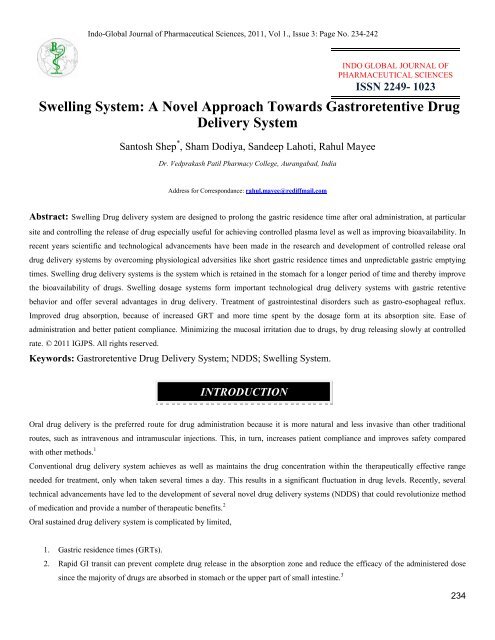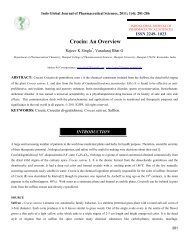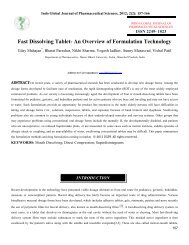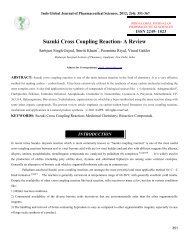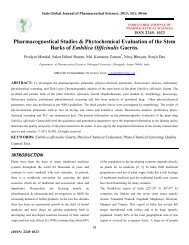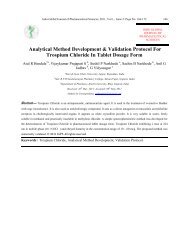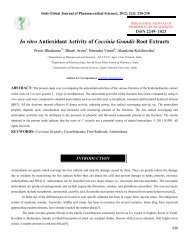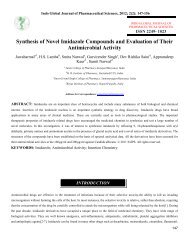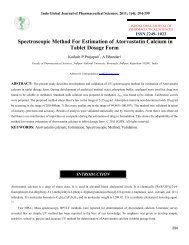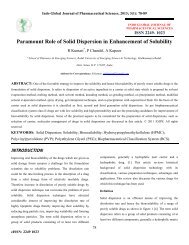Swelling System: A Novel Approach Towards Gastroretentive Drug ...
Swelling System: A Novel Approach Towards Gastroretentive Drug ...
Swelling System: A Novel Approach Towards Gastroretentive Drug ...
- No tags were found...
You also want an ePaper? Increase the reach of your titles
YUMPU automatically turns print PDFs into web optimized ePapers that Google loves.
Indo-Global Journal of Pharmaceutical Sciences, 2011, Vol 1., Issue 3: Page No. 234-242INDO GLOBAL JOURNAL OFPHARMACEUTICAL SCIENCESISSN 2249- 1023Santosh Shep * , Sham Dodiya, Sandeep Lahoti, Rahul MayeeDr. Vedprakash Patil Pharmacy College, Aurangabad, IndiaAddress for Correspondance: rahul.mayee@rediffmail.comrate. © 2011 IGJPS. All rights reserved.Keywords: <strong>Gastroretentive</strong> <strong>Drug</strong> Delivery <strong>System</strong>; NDDS; <strong>Swelling</strong> <strong>System</strong>.INTRODUCTIONwith other methods. 1of medication and provide a number of therapeutic benefits. 2Oral sustained drug delivery system is complicated by limited,1. Gastric residence times (GRTs).since the majority of drugs are absorbed in stomach or the upper part of small intestine. 3<strong>Swelling</strong> <strong>System</strong>: A <strong>Novel</strong> <strong>Approach</strong> <strong>Towards</strong> <strong>Gastroretentive</strong> <strong>Drug</strong>Delivery <strong>System</strong>Abstract: <strong>Swelling</strong> <strong>Drug</strong> delivery system are designed to prolong the gastric residence time after oral administration, at particularsite and controlling the release of drug especially useful for achieving controlled plasma level as well as improving bioavailability. Inrecent years scientific and technological advancements have been made in the research and development of controlled release oraldrug delivery systems by overcoming physiological adversities like short gastric residence times and unpredictable gastric emptyingtimes. <strong>Swelling</strong> drug delivery systems is the system which is retained in the stomach for a longer period of time and thereby improvethe bioavailability of drugs. <strong>Swelling</strong> dosage systems form important technological drug delivery systems with gastric retentivebehavior and offer several advantages in drug delivery. Treatment of gastrointestinal disorders such as gastro-esophageal reflux.Improved drug absorption, because of increased GRT and more time spent by the dosage form at its absorption site. Ease ofadministration and better patient compliance. Minimizing the mucosal irritation due to drugs, by drug releasing slowly at controlledOral drug delivery is the preferred route for drug administration because it is more natural and less invasive than other traditionalroutes, such as intravenous and intramuscular injections. This, in turn, increases patient compliance and improves safety comparedConventional drug delivery system achieves as well as maintains the drug concentration within the therapeutically effective rangeneeded for treatment, only when taken several times a day. This results in a significant fluctuation in drug levels. Recently, severaltechnical advancements have led to the development of several novel drug delivery systems (NDDS) that could revolutionize method2. Rapid GI transit can prevent complete drug release in the absorption zone and reduce the efficacy of the administered dose234
Indo-Global Journal of Pharmaceutical Sciences, 2011, Vol 1., Issue 3: Page No. 234-242The current controlled release technology has made it possible to release drugs at a constant release rate for longer periods of timeranging from days to years. However, this benefit has not satisfied a variety of important drugs that1. Are locally active in the stomach2. Gets absorbed from the stomach or in the upper small intestine3. Are unstable in the intestinal or colonic environment4. Exhibit low solubility’s at high pH values. 4These limits promoted the development of gastroretentive drug delivery systems (GRDDSs). <strong>Gastroretentive</strong> dosage forms are drugdelivery systems which remain in the stomach for an extended period of time and allow both spatial and time control of drugliberation. Basically gastroretentive systems swells following ingestion and is retained in the stomach for a number of hours, while itcontinuously releases the incorporated drug at a controlled rate to preferred absorption sites in the upper intestinal tract. 5Gastrointestinal retention depends on many factors such as density of the dosage form, size of the dosage form, fasting or fedcondition, nature of the meal taken, sleep, posture, etc. It also depends strongly on a complicated and unpredictable gastric emptyingwith migrating myoelectric complex motility of the stomach. 6The gastric emptying occurs in both the cases in fasting as well as in fed states. Nevertheless the pattern of motility differsmarkedly in two states. In case of fasted state an interdigestive series of electrical events occurs in cyclic manner both throughstomach and small intestine every 2-3 hours. This electrical activity is termed as interdigestive myoelectric cycle or migratingmyoelectric complex (MMC) which is further divided into four phases;Phase I (Basic Phase):-It is a quiescent period with rare contractions lasting from 40-60 minutes.Phase II (Preburst Phase):-It lasts for 20-40 minutes and consists of intermittent action potentials and contractions thatgradually increase in intensity and frequency as the phase progresses.Phase III (Burst Phase):- This phase is relatively short and represents intense, large regular contractions of 4-6 minutes induration. It is phase III which earns the cycle the term “housekeeper” waves, as it enables to sweep away all undigestedmaterials out of stomach and down to the small intestine. It has been observed that as phase III of one cycle reaches the endof small intestine, phase III of the next cycle begins in duodenum.Phase IV:-It lasts for 0-5 min. It takes place between phase III and phase I of two consecutive cycles.7, 8.Studies revealed that in the fed state, the gastric emptying rate slowed since the onset of MMC is delayed.Requirements for gastric retention. 9One of the key issues is that the dosage form must be able to withstand the forces caused by peristaltic waves in the stomach and theconstant contractions and grinding and churning mechanisms. To function as a gastric retention device, it must resist premature gastricemptying. Furthermore, once its purpose has been served, the device should be removed from the stomach with ease.235
Indo-Global Journal of Pharmaceutical Sciences, 2011, Vol 1., Issue 3: Page No. 234-242<strong>Approach</strong>es to Gastric Retention 4 :-Figure 1: <strong>Approach</strong>es for GDDSAdvantages of <strong>Gastroretentive</strong> <strong>Drug</strong> Delivery <strong>System</strong>. 101. Improves patient compliance by decreasing dosing frequency.2. Bioavailability enhances despite first pass effect because fluctuations in plasma drug concentration is avoided, adesirable plasma drug concentration is maintained by continuous drug release.3. Gastric retention time is increased because of buoyancy.4. Enhanced absorption of drugs which solubilise only in stomach5. <strong>Drug</strong> releases in controlled manner for prolonged period.6. Site-specific drug delivery to stomach can be achieved.7. Superior to single unit floating dosage forms as such microspheres releases drug uniformly and there is no risk of dosedumping.8. Avoidance of gastric irritation, because of sustained release effect.9. Better therapeutic effect of short half-life drugs can be achieved.Limitations of the Techniques of Gastroretention: 11More predictable and reproducible floating properties should be achieved in all the extreme gastric conditions.1. The floating systems in patients with achlorhydria can be questionable in case of swellable systems, faster swelling propertiesare required and complete swelling of the system should be achieved well before the gastric emptying time.2. Bioadhesion in the acidic environment and high turnover of mucus may raise questions about the effectiveness of thistechnique. Similarly retention of high density systems in the antrum part under the migrating waves of the stomach isquestionable.236
Indo-Global Journal of Pharmaceutical Sciences, 2011, Vol 1., Issue 3: Page No. 234-2423. Not suitable for drugs that may cause gastric lesions e.g. Non- steroidal anti inflammatory drugs. <strong>Drug</strong>s that are unstable inthe strong acidic environment, these systems do not offer significant advantages over the conventional dosage forms fordrugs that are absorbed throughout the gastrointestinal tract.4. The mucus on the walls of the stomach is in a state of constant renewal, resulting in Unpredictable adherence.5. In all the above systems the physical integrity of the system is very important and primary requirement for the success ofthese systems.Factors affecting the gastroretentive system. 51. Density – Gastric retention time (GRT) is a function of dosage form buoyancy that is dependent on the density.2. Size – Dosage form units with a diameter of more than 7.5 mm are reported to have an increased GRT compared with thosewith a diameter of 9.9 mm.3. Shape of dosage form – Tetrahedron and ring shaped devices with a flexural modulus of 48 and 22.5 kilo pounds per squareinch (KSI) are reported to have better GRT 90% to 100% retention at 24 hours compared with other shapes.4. Single or multiple unit formulation – Multiple unit formulations show a more predictable release profile and insignificantimpairing of performance due to failure of units, allow co-administration of units with different release profiles or containingincompatible substances and permit a larger margin of safety against dosage form failure compared with single unit dosageforms.5. Fed or unfed state – Under fasting conditions, the GI motility is characterized by periods of strong motor activity or themigrating myoelectric complex (MMC) that occurs every 1.5 to 2 hours. The MMC sweeps undigested material from thestomach and, if the timing of administration of the formulation coincides with that of the MMC, the GRT of the unit can beexpected to be very short. However, in the fed state, MMC is delayed and GRT is considerably longer.6. Nature of meal – Feeding of indigestible polymers or fatty acid salts can change the motility pattern of the stomach to a fedstate, thus decreasing the gastric emptying rate and prolonging drug release.7. Caloric content – GRT can be increased by 4 to10 hours with a meal that is high in proteins and fats.8. Frequency of feed – The GRT can increase by over 400 minutes when successive meals aregiven compared with a singlemeal due to the low frequency of MMC.9. Gender – Mean ambulatory GRT in males (3.4±0.6 hours) is less compared with their age and race matched femalecounterparts (4.6±1.2 hours), regardless of the weight, height and body surface.10. Age – Elderly people, especially those over 70, have a significantly longer GRT.11. Posture – GRT can vary between supine and upright ambulatory states of the patient.12. Concomitant drug administration – Anticholinergics like atropine and propantheline, opiates like codeine and prokineticagents like metoclopramide and cisapride can affect floating time.13. Biological factors – Diabetes and Crohn’s disease, etc.Selection of drug candidates for gastroretentive dosage forms.The gastro-intestinal (GI) tract is composed of several regions differing in anatomy, biochemical environment, microbial flora,expression of transporters, and absorption characteristics. There are several processes that may occur simultaneously following drug237
Indo-Global Journal of Pharmaceutical Sciences, 2011, Vol 1., Issue 3: Page No. 234-242release from a dosage form in the GI tract, including: chemical/enzymatic/ bacterial degradation, absorption (passive and/or active),precipitation, efflux by P-glycoprotein pump, and metabolism by Cyp450 enzymes. As a consequence the pharmacokinetic profile of adrug may be influenced by its delivery site. 12<strong>Drug</strong>s that would benefit from gastric retention include: CNS drugs (for Parkinson disease, epilepsy, Alzheimer and migraine) Antiviralproducts (for HIV, herpes and hepatitis) and certain antibiotics, Anti-hypertension drugs, Anti-diabetic agents for Type 2 diabetes<strong>Drug</strong>s for local treatment of GI infections, and gastric enzyme replacement. 13<strong>Swelling</strong> systems.After being swallowed, these dosage forms swell to a size that prevents their passage through the pylorus. As a result, the dosage formis retained in the stomach for a long period of time. These systems are sometimes referred to as plug type systems because they tend toremain lodged at the pyloric sphincter. These polymeric matrices remain in the gastric cavity for several hours even in the fed state.Sustained and controlled drug release may be achieved by selecting a polymer with the proper molecular weight and swellingproperties. Upon coming in contact with gastric fluid, the polymer imbibes water and swells. The extensive swelling of these polymersis a result of the presence of physical–chemical crosslinks in the hydrophilic polymer network. These cross-links prevent thedissolution of the polymer and thus maintain the physical integrity of the dosage form. A balance between the extent and duration ofswelling is maintained by the degree of crosslinking between the polymeric chains. A high degree of crosslinking retards the swellingability of the system and maintains its physical integrity for a prolonged period (see below figure). On the other hand, a low degree ofcross-linking results in extensive swelling followed by the rapid dissolution of the polymer. An optimum amount of cross-linking isrequired to maintain a balance between swelling and dissolution. 14GastricfluidHigh degreeof cross-linkingTimeGastricfluidLow degreeof cross-linkingFigure 2: Relationship between the degree of cross-linking of the polymeric chains and the swelling behavior of swellingsystems. 14238
Indo-Global Journal of Pharmaceutical Sciences, 2011, Vol 1., Issue 3: Page No. 234-242POLYMERS & OTHERINGREDIENTS[15]Following types of ingredients can be incorporated into swelling dosage form in addition to thedrugs:Hydrocolloids- Acacia, Pectin, Chitosan, Agar, Casein, Bentonite, Veegum, Hydroxy Propyl Methyl Cellulose (HPMC) (K4M,K100M and K15M), Gellan gum, Sodium Carboxy Methyl Cellulose (CMC), Methyl Cellulose (MC), Hydroxy Propyl Cellulose(HPC).PHARAMCOKINETIC ASPECTS [1-6]1. Absorption window-validation that the drug is within the category of narrows absorption window agents:Currently various experimental techniques are available that permit us to verify the absorption properties of the tested molecule, todetermine the mechanism of intestinal absorption and to elucidate the permeability at different regions of the GI tract. In general,appropriate candidates for CR-GRDF are molecules that have poor colonic absorption but are characterized by better absorptionproperties at the upper parts of the GI tract. In the case of absorption by active transporters that are capacity limited, the efficacy of thetransport activity may increase following sustained presentation of the drug to the transporting enzymes in comparison to non CRmode of administration.2. Enhanced bioavailability:Once it has been ascertained that the compound in question is defined as narrow absorption window, the possibility of improvingbioavailability by continuous administration of the compound to the specific site should be tested. For example, certainbisphosphonates, including alendronate, are absorbed directly from the stomach. However, the magnitude of this pathway remainsmodest even in the case where the prolonged gastric retention of the bisphosphonate in rats is produced by experimental/surgicalmeans. On the other hand, the bioavailability of riboflavin and levodopa CR-GRDF is significantly enhanced in comparison toadministration of non-GRDF CR polymeric formulations. It may be concluded that several different processes, related to absorptionand transit of the drug in the gastrointestinal tract, act concomitantly and influence the magnitude of drug absorption. Therefore, invivo studies are necessary to determine the release profile of the drug from the dosage form that will provide enhanced bioavailability.3. Enhanced first pass biotransformationIn a similar fashion to increased efficacy of active transporters exhibiting capacity limited activity, the pre-systemic metabolism of thetested compound may be considerably increased when the drug is presented to the metabolic enzymes (cytochrome P450, in particularCYP3A4) in a sustained manner, rather than by a bolus input.4. Improved bioavailability due to reduced P-glycoprotein (P-gp) activity in the duodenumIn apparent contrast to the higher density of CYP3A4 at the upper part of the intestine, P-gp mRNA levels increase longitudinallyalong the intestine such that the highest levels are located in the colon. Therefore, for drugs that are P-gp substrate and do not undergooxidative metabolism, such as digoxin, CR-GRDF may elevate absorption compared to the immediate and CR dosage forms.239
Indo-Global Journal of Pharmaceutical Sciences, 2011, Vol 1., Issue 3: Page No. 234-2425. Reduced frequency of dosingFor drugs with relatively short biological half-life, sustained and slow input from CR-GRDF may result in a flip-floppharmacokinetics and enable reduced dosing frequency. This feature is associated with improved patient compliance, and therebyimproves therapy.6. Targeted therapy for local ailments in the upper GI tractThe prolonged and sustained administration of the drug from the GRDF to the stomach may be advantageous for local therapy in thestomach and the small intestine. By this mode of administration, therapeutic drug concentrations may be attained locally while thesystemic concentrations, following drug absorption and distribution, are minimal.PHARMACODYNAMICASPECTS [16]1. Reduced fluctuations of drug concentration:Continuous input of the drug following CR-GRDF administration produces blood drug concentrations within a narrower rangecompared to the immediate release dosage forms. Thus, fluctuations in drug effects are minimized and concentration dependentadverse effects that are associated with peak concentrations can be prevented. This feature is of special importance for drugs with anarrow therapeutic index.2. Improved selectivity in receptor activationMinimization of fluctuations in drug concentration also makes it possible to obtain certain selectivity in the elicited pharmacologicaleffect of drugs that activate different types of receptors at different concentrations.3. Reduced counter-activity of the bodyIn many cases, the pharmacological response which intervenes with the natural physiologic processes provokes a rebound activity ofthe body that minimizes drug activity. Slow input of the drug into the body was shown to minimize the counter activity leading tohigher drug efficiency.4. Extended time over critical (effective) concentrationFor certain drugs that have non-concentration dependent pharmacodynamics, such as beta-lactam antibiotics, the clinical response isnot associated with peak concentration, but rather, with the duration of time over a critical therapeutic concentration. The sustainedmode of administration enables extension of the time over a critical concentration and thus enhances the pharmacological effects andimproves the clinical outcomes.5. Minimized adverse activity at the colonRetention of the drug in the GRDF at the stomach minimizes the amount of drug that reaches thecolon. Thus,undesirable activities of the drug in colon may be prevented. This pharmacodynamic aspect provides the rationale forGRDF formulation for beta-lactam antibiotics that are absorbed only from the small intestine, and whose presence in the colon leads240
Indo-Global Journal of Pharmaceutical Sciences, 2011, Vol 1., Issue 3: Page No. 234-242to development of microorganism’s resistance. In most cases, due complexity of pharmacokinetic and pharmacodynamic parameters,in vivo studies are required to establish the optimal dosage form for a specific drug. For a certain drug, interplay of itspharmacokinetic and pharmacodynamic parameters will determine the effectiveness and benefits of the CR-GRDF compared to theother dosage forms. In the next chapters we discuss the development and evaluation of CR-GRDF for several drugs that wereperformed in our laboratory.EVALUATION PARAMETERS1. Water uptake study. 6The swelling of the polymers can be measured by their ability to absorb water and swell. The swelling property of the formulation canbe determined by various techniques. The water uptake study can be done by using USP dissolution apparatus II. Distilled water canbe used as medium, 900 ml rotated at 50 rpm. The temperature of medium should be maintained at 37±0.5 ◦C throughout the study.After a selected time intervals, the tablets should be withdrawn, blotted to remove excess water and weighed. <strong>Swelling</strong> characteristicscan be expressed in terms of water uptake (WU) asWU (%) = weight of the swollen tablet − initial weight of the tabletInitial weight of the tablet × 1002. XRay/ gamma scintigraphy. 2X‐Ray/Gamma Scintigraphy is a very popular evaluation parameter for swelling dosage form nowadays. It helps to locate dosage formin the gastrointestinal tract (GIT), by which one can predict and correlate the gastric emptying time and the passage of dosage form inthe GIT. Here the inclusion of a radio‐opaque material into a solid dosage form enables it to be visualized by X‐rays. Similarly, theinclusion of a γ‐emitting radionuclide in a formulation allows indirect external observation using a γ‐camera or scintiscanner. In caseof γ‐scintigraphy, the γ‐rays emitted by the radionuclide are focused on a camera, which helps to monitor the location of the dosageform in the GIT.241
Indo-Global Journal of Pharmaceutical Sciences, 2011, Vol 1., Issue 3: Page No. 234-242REFERENCES1. Tao S, and Desai T. Gastrointestinal patch systems for oral drug delivery DDT, Volume 10, Number 13 - July 2005.2. Nasa P, Mahant S, Sharma D. Floating systems:A novel approach towards gastroretentive drug delivery systems. International Journal ofPharmacy and Pharmaceutical Sciences - Vol 2, Suppl 3, (2010),0975-1491.3. Surana A. and Kotecha R. An overview on various approaches to oral controlled drug delivery system via gastroretention. ISSN 0976 –044X, Volume 2, Issue 2, Article 014, May – June (2010).4. Sheu M, Chen R, Ho.Hsiu, Yu C. Development of swelling/floating gastroretentive drug delivery system based on a combination ofhydroxyethyl cellulose and sodium carboxymethyl cellulose for Losartan and its clinical relevance in healthy volunteers with CYP2C9polymorphism. European Journal of Pharmaceutical Sciences 39 (2010) ,82–89.5. K Vinod, Vasa Santhosh, S Anbuazaghan, Banji David, A Padmasri, S Sandhya. <strong>Approach</strong>es for gastrotentive drug delivery systemsInternational Journal of Applied Biology and Pharmaceutical Technology -0976-4550 Volume: I: Issue-2: Aug-Oct –(2010),589-601.6. Chavanpatil M, Jain P, Chaudhari S, Shear R, Vavia P. <strong>Novel</strong> sustained release, swellable and bioadhesive gastroretentive drug deliverysystem for ofloxacin. International Journal of Pharmaceutics 316 (2006),86–927. Vyas S P and Khar R K. Controlled drug delivery concepts and advances, First edition, (2002),197-198.8. Samyuktha Rani, Vedha Hari B.N, Reddy B, S Punitha, Devi P, Rajamanickam V. The recent developments on gastric floating drugdelivery systems: an overveiw. International Journal of PharmTech Research CODEN (USA):Vol.2, No.1,Jan-Mar 2010, 524-534.9. Dr. Rocca J, Midian H, Shah K. Progresses in <strong>Gastroretentive</strong> <strong>Drug</strong> Deliver y <strong>System</strong>s. Business Briefing : Pharmatech (2003)10. Gaba P, Gaba M, Garg R, Dr. Gupta G. Floating Microspheres: A Review. Vol. 6, 5(2008).11. Shinde A, Dr. More H, <strong>Gastroretentive</strong> <strong>Drug</strong> Delivery <strong>System</strong>: An Overview. Vol. 6, 1 (2008).12. Kagan L, Hoffman A. Selection of drug candidates for gastroretentive dosage forms: Pharmacokinetics following continuous intragastricmode of administration in a rat model. European Journal of Pharmaceutics and Biopharmaceutics. 69 (2008), 238–246.13. Afargan M, Lapidot N. Controlled release – gastric retention. <strong>Drug</strong> Delivery Supplement.T and F Informa UK Ltd. 2005, 8-9.14. Chawla G, Gupta P, Koradia V, Bansal A. Gastroretention a Means to Address Regional Variability in Intestinal <strong>Drug</strong> Absorption.Pharmaceutical Technology. July 2003, 50-68.15. Mathu P, Saroha K, Syan N, Verma S, Nanda S, Valecha V. An overview on recent advancements and developments in gastroretentivebuoyant drug delivery system. Der Pharmacia Sinica.2011, 2 (1):161-169.16. Hoffman A, Stepensky D, Lavy E, Klausner S, Michael Friedman. Pharmacokinetic and pharmacodynamic aspects of gastroretentivedosage forms. International Journal of Pharmaceutics .277 (2004) 141–153.242


